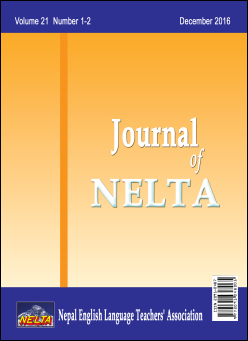Reading as Multi-Tasking: Unravelling Invisible Cognitive Processes in Reading
DOI:
https://doi.org/10.3126/nelta.v21i1-2.20210Keywords:
Spotting/detecting, Crowding, Clustering, Competing, Selecting, Erasing, Replacing, Catapulting, Centripetal and centrifugal processesAbstract
When we read a text , several processes take place in our mind simultaneously. As we know, the first is the visual process which enables us to read graphic marks or letters that make words on paper or on screen. The writer’s words, phrases, clauses, and sentences fall onto the reader’s eye screen. This, as we know, happens almost automatically and effortlessly unless the handwriting is illegible. As soon as words fall onto our eyes, the process of interpretation begins. A competent reader, if she is a competent user of the language as well, does several things synchronously. She mentally registers the speaker’s use of norm-deviating and norm-approximating features. An expert reader is sensitive to all these features as well as grammatical, semantic, pragmatic, and cultural subtleties and nuances. Each of these features deserves an independent treatment and is worth a separate research project. The present paper focuses on appropriate use of vocabulary or use of appropriate vocabulary in writing. Understandably, not every writer is a proficient user of the language and so when a competent user of the language reads a text produced by a not-so-competent writer, the former goes through several processes such as (1) identification of an inappropriate word or expression, (2) crowding of synonyms, (3) clustering or bunching of synonyms, (4) intergroup competition of synonyms, (5) de-crowding by less appropriate bunch(es), (6) intra-group competition of synonyms, (7) selection of an appropriate word, (8) de-crowding by some items of the chosen group, (9) erasure of the inappropriate word used by the writer, and (10) replacement of the inappropriate word with what the reader thinks is an appropriate word or phrase. We can group these ten processes into three main categories-catapulting, centripetal process and centrifugal process.
Journal of NELTA, Vol. 21, No. 1-2, 2016, Page: 140-151
Downloads
Downloads
Published
How to Cite
Issue
Section
License
© Nepal English Language Teachers’ Association (NELTA)
Authors are required to transfer their copyright to the Nepal English Language Teachers' Association (NELTA)
The Journal of NELTA is copyright by Nepal English Language Teachers’ Association (NELTA). Apart from citing/referencing in academic works, no part of any materials may be reproduced by any process without prior written permission from its copyright owner – NELTA. Requests and enquiries concerning reproduction and rights may be addressed to NELTA or the editorial board at neltaeditorialboard@gmail.com.




